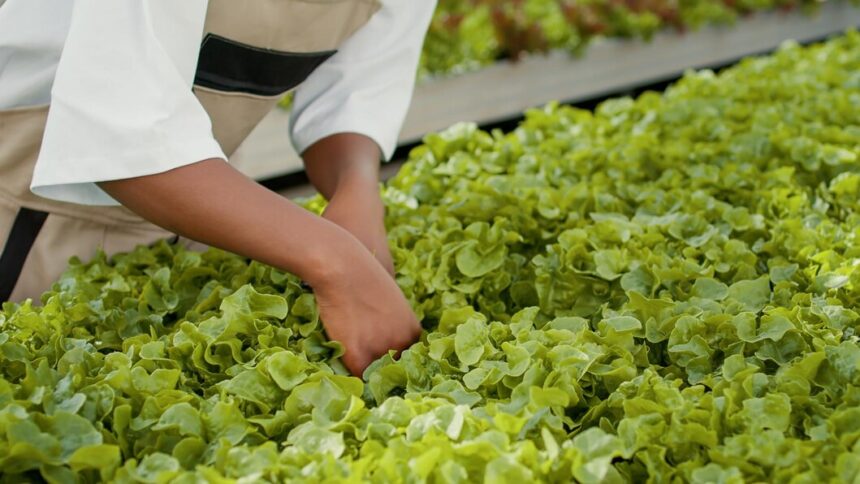Lettuce is one of the most popular leafy greens grown worldwide, valued for its crisp texture and nutritional benefits. For South African farmers, cultivating lettuce can be a profitable venture, given the crop’s relatively short growth cycle and high market demand. This article provides a detailed overview of the entire process of growing lettuce from seed to harvest, including essential inputs, equipment, and disease management strategies.
1. Land Preparation
Soil Type:
Lettuce thrives best in well-drained, loamy soils rich in organic matter. Ideal pH levels are between 6.0 and 7.0. Farmers should consider conducting a soil test to determine nutrient levels and pH before planting.
Preparation Steps:
- Tillage: Begin with deep tillage to break up compacted soil and improve aeration. Use a tractor with a plow or rototiller for efficient soil preparation.
- Adding Organic Matter: Incorporate compost or well-rotted manure to enhance soil fertility and structure.
- Bed Formation: Form raised beds or furrows (1.2 meters wide and 20-30 cm high) to facilitate drainage and improve plant growth.
2. Sowing Seeds
Seed Selection:
Choose high-quality, disease-resistant lettuce varieties suitable for local climate conditions, such as Butterhead, Romaine, or Iceberg.
Sowing Methods:
- Direct Sowing: Seeds can be sown directly into prepared beds at a depth of 1-2 cm, with rows spaced about 30 cm apart.
- Transplanting: Alternatively, seeds can be started in seed trays and transplanted when seedlings are about 4-6 weeks old, ensuring they have 4-6 true leaves.
Spacing:
Space seedlings 20-30 cm apart within rows to allow for adequate growth and airflow.
3. Water Requirements
Lettuce requires consistent moisture for optimal growth.
- Amount: Approximately 25-30 mm of water per week is ideal, depending on weather conditions and soil type.
- Irrigation: Implement drip irrigation or sprinkler systems to provide adequate moisture without waterlogging the plants. Watering should occur early in the morning to reduce evaporation and fungal disease risk.
4. Fertilization
Fertilization is critical for healthy lettuce growth.
- Types of Fertilizers:
- Pre-planting: Incorporate a balanced fertilizer (such as 10-10-10 NPK) into the soil before planting.
- Side-Dressing: Apply nitrogen-rich fertilizers (like urea) at 2-4 weeks after planting to encourage leafy growth. Monitor nitrogen levels as excess nitrogen can lead to lush foliage at the expense of quality.
Application:
Fertilizers should be applied according to soil test recommendations, and care should be taken to avoid fertilizer burn.
5. Growth Stages
Germination (Days 1-10):
Seeds typically germinate within 7-14 days. Keep the soil consistently moist during this period.
Seedling Stage (Days 10-30):
During this phase, focus on providing adequate light (preferably 12-16 hours) if growing indoors or in shaded areas. Thinning seedlings may be necessary to reduce competition.
Vegetative Stage (Days 30-60):
This is when the plants will begin to grow rapidly. Regular monitoring for water and nutrient levels is essential.
Maturity and Harvest (Days 60-80):
Depending on the variety, lettuce is typically ready to harvest between 60 to 80 days after sowing. Look for heads that are firm and well-formed.
6. Disease and Pest Management
Lettuce is susceptible to various diseases and pests. Early identification and management are crucial.
Common Diseases:
- Downy Mildew: Look for yellowing leaves with a fuzzy gray growth. Use fungicides at the first sign of infection and ensure proper airflow around plants.
- Powdery Mildew: Identify by white powdery spots on leaves. Control using fungicides and ensure plants are not overcrowded.
Common Pests:
- Aphids: Check for sticky residue or curling leaves. Use insecticidal soap or neem oil as an organic control.
- Cutworms: Look for seedlings cut at the base. Use diatomaceous earth or traps to manage cutworms.
Pesticide Application:
Apply pesticides and herbicides according to label instructions and local regulations. It’s essential to follow integrated pest management (IPM) practices to minimize pesticide use and maintain ecological balance.
7. Harvesting Lettuce
Timing:
Harvest lettuce in the morning to preserve crispness and minimize wilting. Use a sharp knife or scissors to cut heads just above the soil line.
Method:
Harvesting can be done manually or using a small harvesting machine for larger operations.
8. Post-Harvest Storage
Cooling:
Immediately after harvest, cool the lettuce to extend shelf life. Use a cooler or ice water baths to bring down the temperature quickly.
Storage Conditions:
Store harvested lettuce at temperatures between 0°C and 4°C with high humidity (90-95%) to maintain freshness. Consider using perforated plastic bags or containers to reduce moisture loss while allowing airflow.
Growing lettuce from seed to harvest requires careful attention to soil preparation, water management, fertilization, pest and disease control, and post-harvest practices. By following these guidelines, South African farmers can cultivate high-quality lettuce, contributing to both local markets and their overall agricultural success. With proper management and practices, lettuce farming can be a rewarding and sustainable agricultural endeavor.







